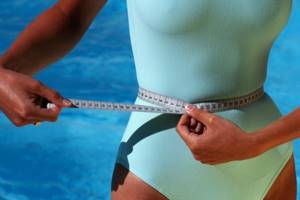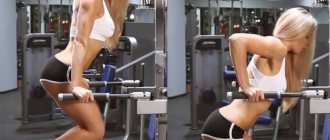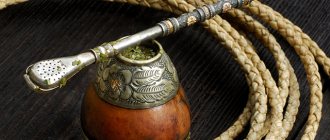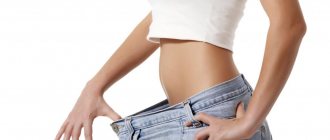How to take body measurements correctly and how to determine the results of training
When you are seriously passionate about something, you probably do it with all your heart, while not forgetting to monitor your results.
After all, this equally applies to sports. If you are determined to achieve any results, you monitor the progress of each workout and the changes that occur in your body. This article will help you on how to take body measurements correctly. But there are a lot of ways to determine the results of training, so in order not to bother you, I will tell you about the most basic of them.
To begin with, we will determine the effectiveness of training for the purpose of losing weight and gaining muscle mass, there are three of them: weighing, body measurements and measuring subcutaneous fat. These three methods complement each other and together give a complete picture of what is happening.
The first method is weighing.
The simplest and most regular thing that all people involved in sports do is weigh themselves.
. It is necessary to monitor your weight, but you cannot rely on this indicator alone. Since when losing weight, a situation may arise that you, on the contrary, will gain a little weight, but this weight will not be gained by adding fat, but by increasing muscle mass. However, as is correct, this is a very low probability, since when you dry out (lose weight), your caloric intake decreases, and for muscle growth, on the contrary, you need to increase caloric intake (excess). Although this also happens - weight increases (body weight and volume), but not due to the increase in muscle tissue, but due to the appearance of excess subcutaneous fat or vice versa...
Basic rules for weighing:
- You need to weigh yourself every week, at the same time and on the same day of the week.
- You need to weigh yourself after using the toilet and before breakfast.
But in order for the picture to be more complete, in addition to weighing, you should take measurements of body volumes and measurements of fat folds using a caliper, because only then will you track your achievements and body changes over time (as correctly as possible). You can learn more about measuring subcutaneous fat in the article: How to measure subcutaneous fat.
https://youtu.be/AwVn6W7UUUg
Progress monitoring
Record all received data in a notebook or table. It is easy to draw the table yourself on a sheet of paper. Place it in a visible place and record the results of all measurements taken. This visual method is the best. After a short period, you will remember everything and will automatically know what measurements to take when losing weight.
Entries can also be made in a notebook, and the average value for the week can be entered into the table. A notepad is more convenient due to its mobility, because you can take a notebook with you anywhere. The disadvantage of a notepad is that you cannot see progress over a long time, and the data will be scattered across different pages.
The second method is body measurements
It is more accurate than the first, but as already said, they need to be combined.
Body measurements (body measurements) can be made with a regular centimeter tape, or with paper or thread, and then take readings with a ruler. The first method is more convenient, but if you don’t have a measuring tape at hand, then the second method is also perfect. So, how should you measure correctly and in what places? Let's talk about all this in order.
Body measurements for weight loss and weight gain
Wrist
– the measurement takes place with a relaxed hand, in the thinnest place (above the protruding bone).
Forearm
(part of the arm from the elbow to the wrist). It is measured in two states - relaxed and tense. In the first, the arm hangs calmly along the body, in the second, the arm is bent at an angle of 90 degrees, the muscles are tense. In both cases, the thickest part is measured.
Shoulder
(this is the part of the arm from the elbow to the shoulder, not from the shoulder to the neck). It is measured in a calm state - the arm hangs along the body, relaxed. Freezing in a tense state - the hand is raised and clenched into a fist at head level.
Neck
. It is measured in a calm state - the chin is slightly raised, the measuring tape lies horizontally, and not obliquely. Do not try to pull your neck into your body or stretch it, or even press your chin to your chest - this will not improve your training results, but on the contrary, you will deceive yourself.
Rib cage -
measured at the widest point for men and at the most protruding points for women. In a calm state, the measurement is taken after a calm, normal inhalation (do not inhale too deeply or stick out your chest). In a tense state, you need to tense the muscles of your back and chest and slightly spread your elbows to the sides. There is another option for measuring the chest. You measure it at maximum inhalation, then also at maximum exhalation. Add up the resulting readings, then divide by two, the resulting number is the average volume of your chest.
Waist -
measured at the thinnest point, if you have one. And if there is a protruding belly, then the measurement is made, on the contrary, along the widest part. Again, do not try to deceive the readings, so do not pull in your stomach, and do not pull the measuring tape too tightly, but it should not sag either - just adjust it to the measuring site. If you want to measure your waist in a tense state, then tense your abdominal muscles and measure.
Buttocks -
are measured, as a rule, in a relaxed state, at the most prominent points. That is why at the very beginning of the article it is said that it is better to take measurements with an assistant; it can be difficult not only to find the most protruding points at the back, but also to measure correctly.
Hip
– the widest part is measured in a relaxed state, either standing quietly or placing a bent leg on a chair. In a tense state - standing, leg straightened, muscles tense.
Shin
– measured at the widest point. Relaxed state - the leg is placed on a chair, tense state - raised on your toes, transfer your body weight to the leg that you are measuring.
Ankle
(located between the foot and shin) - you need to measure while standing on straight legs, in the thinnest part.
Rules and features in body measurements:
- You need to take measurements in the same places, at the same time of day and several times in the same place (for greater accuracy), but the best time is in the morning, after the toilet and before breakfast. Since the human body tends to swell at the end of the day, weight can also fluctuate significantly depending on the amount of food eaten per day.
- Taking body measurements more often than once every two weeks for those who work on mass (muscle growth) does not make sense, since muscle growth is a very long and painstaking process. But for those who are losing weight, measuring once a week is enough...
- It is better if someone helps you take body measurements, because it is inconvenient to carry out such manipulations alone. But if they are not carried out correctly, then the results of the training may not be as encouraging as we would like...
- Do not gently take measurements immediately after training. Since during training the blood vessels and capillaries (reserve) of our body expand, and therefore more blood begins to circulate through the muscles, as a result, the muscles become larger. Yes, you yourself have noticed how after training the muscles “puff up”...
- By the way, the volumes of the right and left parts of the body differ due to the physiological and anatomical characteristics of each person. You will learn more about this in the article: What to do if one pectoral muscle is larger than the other.
- Always write down or remember exactly where and on which side (right or left side of the body) the measurements were taken, so that next time you can take them exactly in the same place.
- Note the state in which the body measurement was taken - relaxed or calm.
How often and when to measure?
Calculations in the form of numbers will make progress much more effective than the opinions of others or visual control. You should measure no more than once or twice a week. If you do this more often, you are unlikely to see much change. And the lack of change will lead you to despair. On the contrary, the difference between the measurements will stimulate you to even greater feats.
It is better to measure in the morning, before breakfast, because then there is no excess volume. If you measure after eating, there will be a slight error. For the same reason, do not take measurements in the evening, when food and water lead to large errors. Even if you are on a strict diet, the load provokes muscle swelling, and in the evening the girth will inevitably be larger.
The third method is measuring subcutaneous fat
In addition to all the above measurements, it is necessary to periodically and regularly measure the fat layer (subcutaneous). Because volumes can increase due to subcutaneous fat, and you will think that it is your muscles growing.
There are a huge variety of methods for determining subcutaneous fat. Therefore, to learn in detail about each of them and choose the most suitable one for yourself, read the article: How to measure subcutaneous fat. Although I recommend a better method - Kalipometry,
since it is one of the accurate and simple ones.
Also, a recording of measurements missed due to lack of time or plain laziness can greatly spoil the picture of intensive training. Can you remember exactly all the numbers you received, say, a couple of weeks ago? It’s unlikely... But without this, it will be unclear how far you have progressed in losing weight or building muscle.
Why fat goes away but weight doesn't change
Muscle mass grows
If you do strength training, your body composition gradually changes: muscle mass increases and body fat decreases. At the same time, the body becomes more toned and slender, but the weight may remain in place.
The photo below is a great example from the Instagram of Staci Ardison, a powerlifter and Nerd Fitness trainer. In the first photo, Stacey weighs 64.5 kg, in the second - 72.5 kg. I can't believe it, right?
It doesn’t matter that the relief is hidden behind a layer of fat. If you do strength training and eat properly, your muscles will grow.
Fluid retention
In the first days of a diet, a person can lose several kilograms at once, judging by the scale. However, there is nothing special to be happy about here: it is not fat that is leaving, but water.
To lose a pound of fat, you need to create a deficit of 7,700 kcal, and this is almost impossible to do in two days, even if you eat nothing at all and exercise (which obviously will not improve your health). This also works in reverse: you can lose fat, but due to water retention, the number on the scale will remain the same.
Your body may retain water for a variety of reasons:
To find out how much weight you've actually lost, you need to know not your weight, but your body fat percentage. There are several ways to determine this.
Other ways to determine training effectiveness
- For those involved in strength training, results can also be recorded based on the number of approaches, repetitions and weights lifted. But all this data must be recorded in a training diary, otherwise you will not be able to monitor your progress.
- For those who develop endurance, it would be useful to record the time spent covering distances, the number of contractions of the heart muscle and the distance covered. All this data also needs to be recorded in your training diary in order to clearly see your achievements.
- And the last method for today is a photo diary,
in principle, it is a good alternative to body measurements. Every month you take three photographs (primary) of your body, without clothes - front, back and side. But you need to constantly take photographs from the same distance and angle, otherwise the training results will not be accurate. As a result, by comparing photographs over several months, you will be able to see the difference not only in numbers, but also externally from the photographs. In this method, you can choose which part of the body to photograph, this will not interfere in any way, but on the contrary...
Some tips
- Don’t be too scared or worried if the weight suddenly “goes up” or the muscles stop growing. In both cases, you need to reconsider your training program and diet. You will learn more about nutrition for weight loss and muscle growth in the section Proper nutrition.
- There can also be many reasons why muscle mass stops growing. Some of the main ones are: lack of nutrients (energy), lack of recovery, no progression of load, poor exercise technique and your energy system is not yet ready for further growth, so it needs to be further developed (train regularly and follow the training program). If you are all If you analyze this, you will find what your problem of stagnation (plateau) is.
- It is quite possible that the weight that quickly escaped decided to settle on your sides and waist again just because a series of holidays passed in your life, and your diet was slightly disrupted. Or maybe you were sick or worked very hard, so you had no time for training.
Summarize
So we looked at the topic: How to take body measurements correctly. And how to determine the results of training?
Based on this, it becomes clear that in any sport it is necessary to analyze and compare the results, but if this is not done, then you will simply “stand still” and not progress. For this very reason, all athletes attach great importance to monitoring their achievements. After all, if you scrupulously monitor any process, then in the end you will learn to manage it (results).
Exercise, eat right and get better - good luck to you.
How to avoid making mistakes when measuring
Unfortunately, it is not enough just to know the technique of how to measure body volumes; you will have to take into account some important nuances of the process itself. We list them below:
- To complete the picture, it is worth finding a large full-length mirror.
- The accuracy of measuring volumes will be higher if you strip down to your underwear or naked.
- Feet should be placed together and not shoulder-width apart, otherwise the accuracy of measuring distances and some volumes will suffer.
- It is recommended to carefully examine your centimeter: it should start at zero. The value of 1 cm should be exactly 1 cm from the zero value. Violation of distances can be found on the cheapest centimeters.
- It is always better to write down the obtained values at once, take several measurements (preferably at least three) on different days for greater accuracy of the results obtained.
From the above, it becomes clear that it is not at all necessary to be a professional couturier or tailor in order to know how to correctly measure body volumes in women. In addition, there is always the opportunity to compare your own measurements with the work of specialists, which will once again confirm your own competence in this matter.
Why are measurements needed?
Single measurements obtained are of no value when losing weight; They can only be used to determine clothing size. Only systematic measurements will be beneficial because they allow you to see progress. Often numbers become an additional source of motivation, since they help not only to record weight loss, but also show its speed and changes in body quality.
The readings will also help determine whether the nutrition and training system is suitable. If necessary, adjustments can be made in a timely manner.
To get more accurate results, you need to measure several parameters at once:
- body weight;
- chest girth;
- waist circumference;
- hip circumference.
- neck;
- wrists;
- forearms and other parts of the body.
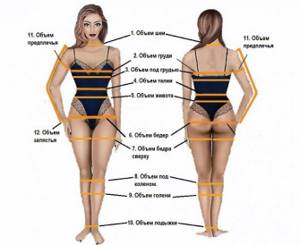
This way it will be possible to determine changes in the quality of the body. This is especially important when the weight remains almost unchanged, while there is less fat and more muscle: it will not be possible to track using only scales.
Regular measurements help track the need to change your training schedule, reduce or increase calories. Changes in metabolic rate can be determined.
Types of measurements
Those losing weight need to take various measurements to obtain accurate data. A larger number of measurements will allow you to notice even small progress.
Weighing
Weight is not the only indicator. In the initial stages, however, it helps well to understand whether the training and nutrition program is effective. In addition, the indicator allows you to understand whether you need to reduce calories or increase them. Body quality, however, can change while maintaining the same mass: there is less fat, and more heavier muscles. A person may look slimmer at higher weights if muscles account for more of the mass. To find out why the weight has decreased, you can use a caliper.
Measurements should be taken at regular intervals without shoes or clothing. It is important to weigh yourself at the same time, on an empty stomach. You should go to the toilet before taking measurements. You can use bathroom scales. You need to stand in the middle of the device, slightly spreading your feet to the sides. If you stand on the edge, the indicators may be distorted.
conclusions
- Just because your weight isn't changing doesn't mean you're not losing fat.
- Weight may remain the same due to muscle gain or fluid retention.
- To determine how your body fat percentage is changing, you need a smart scale or a tailor's meter and a body fat percentage calculator.
- Weigh yourself and measure your fat percentage at the same time: in the morning on an empty stomach.
- Don't expect quick changes: fat goes away gradually.
Continue exercising and dieting. You will definitely lose weight, become stronger and fitter.
How to measure volumes correctly?
It is important to take measurements correctly to get more accurate results. Before losing weight, you should measure your parameters for the first time and enter the results into the body measurements table: this way you can track your progress from the beginning. Then it is important to maintain regularity. You can choose any period from 1 week to 2 months. While a person is losing weight, you can measure more often: fat and excess fluid will disappear, and the volumes will become smaller. If the goal is to gain muscle mass, it is better to measure less frequently, since the effect will be little noticeable over short periods of time.
To make the information more reliable, it is better to ask someone to help with measurements. It is important not to tighten the measuring tape too much. It shouldn't sag either. You need to apply it to the body to get an accurate result.
It is better to measure in the morning on an empty stomach, after visiting the toilet. This will prevent distortion of the results due to an increase in waist size and weight after eating, and morning swelling.
Since the circumference of the right and left limbs may differ slightly, you should either take measurements on both sides, or only on one side at a time. It is recommended to write down whether the measurement was taken on the right or left side last time to avoid confusion.
It is better to take off your clothes before manipulation or choose the tightest things: this way the result will be more accurate.
Do not change the tape: there may be a small error due to which the results will be distorted. Stretch bands are not suitable. It is better to choose soft ones, as they better follow the contours of the body.
If your weight stops losing or your muscles grow too slowly, it is better to consult a specialist to adjust your training schedule, increase loads, and change your diet.
In the initial stages, weight loss occurs quickly. Then weight loss and volume reduction slow down. There is no need to worry as this phenomenon is normal. In the initial stages, muscles grow slowly, which is also not a deviation or an indicator of insufficient load.
An important indicator is growth. Since it is constant in an adult, it can be measured once. It is better to do this in the morning, since by the evening the indicator may decrease by 1–2 cm. The remaining parameters should be considered normal for the obtained value. You can check compliance using special tables.
It is better to take each measurement twice. If the data obtained differ, you need to take the arithmetic mean.
You can ask someone to help with measurements. This way, you will not only be able to increase accuracy, but will also be able to avoid the inconveniences that arise when measuring yourself.
If you don’t want to take a lot of measurements for some reason, you can limit yourself to the main ones: weigh yourself, measure your waist, chest and hips, and note the percentage of body fat. Such readings, however, are less accurate and less helpful in monitoring personal progress.
Neck circumference should be measured with relaxed muscles, since muscle mass on this part of the body is not specifically increased; measurements can only be used to determine progress in weight loss. The measuring tape or thread should be in a horizontal position; placing it diagonally will distort the result. You should not try to pull your neck into your body or pull your chin towards your chest. You need to place the tape in the area of the seventh vertebra. Men can find the right point 2-3 cm above the Adam's apple.
Shoulder girdle
Measurements in the shoulder area should be taken while standing. The back should be straight, arms down, shoulders slightly back. The back and shoulder girdle should not be tense. The measuring tape needs to be pulled through the middle of the deltoid muscles, the top of the chest, and the top of the shoulder blades.
Shoulder
The arm between the elbow and the shoulder girdle can be measured in both a relaxed and tense state. To measure the girth with relaxed muscles, you need the limb to hang along the body. To measure with tense muscles, you need to raise your hand and clench your fist in the ear area.
Forearm
The forearm is the part of the arm between the wrist and elbow. It can be measured both with relaxed muscles and in a state of tension. Relaxed forearm is measured when the upper limb hangs freely along the body. To measure tension, you need to bend your arm at the elbow at a right angle. The measurement is taken at the widest part.
Wrist
To take measurements, the elbow is bent at a right angle. This position is more convenient and allows for more accurate results. The tape should be wrapped in the thinnest place, near the brush. In this case, the muscles need to be relaxed.
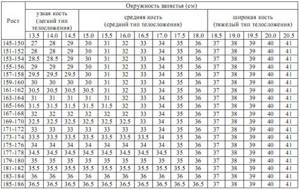
Breast
It is recommended to measure the chest circumference with an assistant. For men, measurements are taken at the widest point, under the shoulder blades and armpits. Women need to measure differently: the tape should be placed at the most protruding point, capturing the nipples. You need to take a calm breath and hold your breath. Another option is also possible: a person takes a deep breath, measures the circumference, then exhales all the air and takes another measurement.

Underbust circumference
This measurement is taken at the narrowest part of the waist; most often it is located at the level of the navel. If a person’s stomach protrudes, you should measure at the widest point. You should not pull in your stomach. You need to relax before taking the measurement. If you wish, you can measure your circumference with your abdominal muscles tense. During measurements, breathe smoothly and calmly, without inflating your stomach too much.

Hips under buttocks
It is necessary to measure under the gluteal muscles, at the widest part. To measure relaxed legs, you can stand straight or place the limb in a bent state on a low stool. The tense hip is also measured. To do this, you need to stand on straightened lower limbs.
Thigh over knee
Stand up straight. Relax or tense your legs; It is better to take measurements of both types. Measure 1-2 cm above the kneecap. You can measure the volume of your hips by stretching your leg to the side.
How to find out your fat percentage
Buy smart scales
Smart scales determine your body fat percentage using BIA (bioelectrical impedance analysis), or body bioimpedance analysis.
When you step on the scale, a small electrical pulse is sent through your body and the percentage of fat, muscle mass, bone weight and amount of water in your body is determined. The data is synced to your smartphone and saved so you can track trends over time.
Here are several models no more expensive than 3,000 rubles:
Calculate using a special calculator
Online calculators use formulas based on the girth of different parts of the body. These are mainly the US Navy method, which takes into account height, neck, waist and hip circumference, and the Covert Bailey method, which uses hip, single thigh, calf and wrist circumferences. Here are a few apps that have such calculators:
To ensure that the data is as accurate as possible, follow several rules:
1. Always measure your parameters at the same time - in the morning on an empty stomach.
2. If possible, ask a friend to measure you. This way you will stand relaxed and the measurements will be as accurate as possible.
3. Take measurements correctly:
- Waist - Measure along the thinnest part of the abdomen, a few centimeters above the navel.
- Hips - Measure across the widest part of your hips.
- One hip - in some calculations you need to measure the circumference of one hip. Measure across the widest part.
- Neck - Measure at the widest part.
- Wrist - Measure at the narrowest part.
- Forearm - Measure at the widest part.
- Shoulder - Measure at the widest part.
- Shin - measure at the widest part.
4. Take measurements once a month, not more often. Body composition does not change quickly, so you will get clearly visible results no sooner than in a month.
5. Write down your results: weight, girth of different parts of the body, fat percentage. This way you can track your progress.
Be guided by clothes
Since a kilogram of fat is much larger than a kilogram of muscle, changes in body composition affect your size.
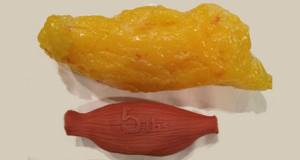
The ratio of the size of a kilogram of fat and a kilogram of muscle / s3.amazonaws.com
With the same weight, you may notice that the shorts have become much looser, the fatty sides that used to hang over the waistband of jeans have gone away, and the tight dress is now not at all tight.
This method is obvious, but many people do not see the changes, preferring to think that the clothes have simply stretched. Look through old photos, see how your clothes fit on you and how they look now. Perhaps a pleasant surprise awaits you.
Measurements for constructing a shoulder model
They may be needed when constructing a dress, blouse, jacket and all other items that are worn on the shoulders.
So, what measurements are needed and how to take them?
Neck circumference - measured at the base of the neck, the measuring tape meets in the center of the neck on the side of the face. Do not strain your neck, keep it in the most natural and comfortable position, look straight.
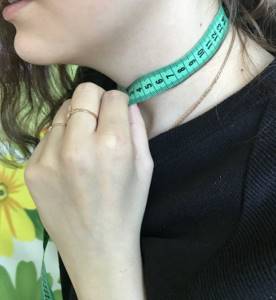
The chest girth is the first - a centimeter runs along the line of the protruding shoulder blades, then under the armpits and converges above the mammary glands.
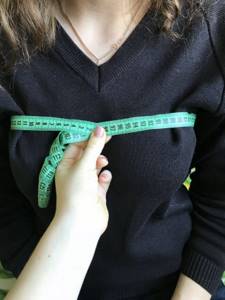
Chest girth is the second - at the back the measuring tape goes along the line of the shoulder blades, at the front it runs along the center of the mammary glands.
You need to take measurements from your chest while standing, not while inhaling deeply, but not while exhaling completely. The measuring tape should fit snugly against the body, but not compress it. Stand straight, don't slouch and relax - this way the measurements will be taken correctly and the product will fit you well.
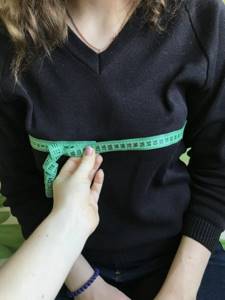
The first width of the chest is a parallel measurement between the facial angles of the armpits, above the mammary glands.
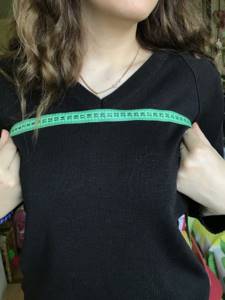
The width of the chest is the second - a centimeter runs parallel to the floor between the facial corners of the armpits through the most protruding points of the chest.
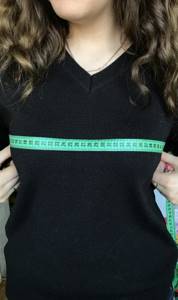
When taking the last two measurements, do not slouch or take too deep a breath or exhale. You should be comfortable and comfortable in the position you are in.
The center of the breast is the measurement between the most voluminous points of the mammary glands.

Back width - measured across the shoulder blades between the armpits.
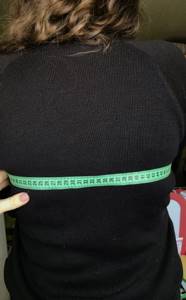
Front waist length is a perpendicular hollow measurement between the highest point of the intended shoulder seam at the base of the neck to the front waistline.
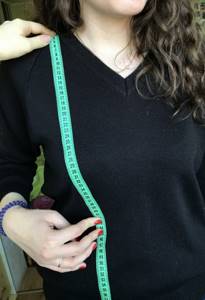
Bust height is the measurement from the highest point of the shoulder seam to the most protruding point of the breast.

The first back waist length is measured from the base of the neck to the outline of the waist.

The length of the back waist is second - runs from the highest point of the supposed shoulder seam at the lower base of the neck to the outline of the waist at the back.

Shoulder width is the measurement from the highest point of the shoulder seam at the base of the neck to the outermost point of the shoulder.
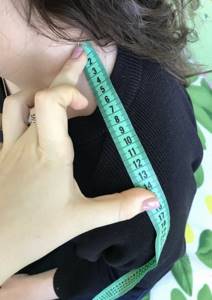
Sleeve length - measured from the extreme shoulder point to the desired length. The arm should be in a comfortable position, slightly bent at the elbow.
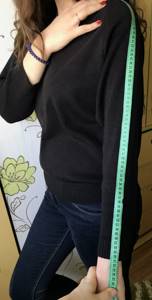
Shoulder circumference - a centimeter runs strictly parallel to the floor at the widest point of the arm. It is measured at the moment when the arm is lowered.
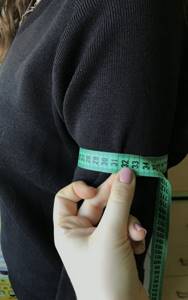
Wrist circumference - measured above the hand along the protruding bones.
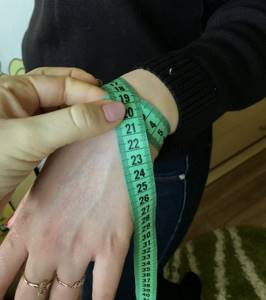
Product length - measured from the bottom of the neck to the desired length. Here it is important to keep your back straight and not lean on one leg - the position of your torso should not be twisted.
Correct technique - accurate readings
To ensure that you get correct results and no errors, follow several important rules. When losing weight, you should take body measurements in front of a mirror that shows you at full height. You will also be able to see if your muscles are relaxed.
Measure all areas more than once to avoid errors.
Each time you take a measurement, place the tape in the same place as the first time. This will allow you to get the correct indicators.
The tape should not dig into the flesh, but it should not sag freely either.
The best option is that the measurements are taken not by you, but by your assistant, husband, boyfriend. Then the numbers will be fair. Invite your family and friends to help.
Measurements for sewing a skirt
The number of measurements for sewing a skirt depends on its model and style. For a circle skirt, for example, you only need the desired length and waist circumference. To sew a pencil skirt, you also need to measure the circumference of your hips.
Skirt length - measured from the waist along the side seam to the desired length.
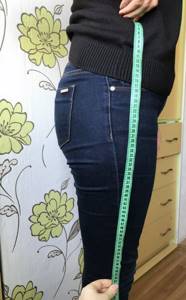
Waist circumference - measurements are taken using the string that you first tied at your waist (the thinnest part of your torso). There is no need to pull in or protrude your stomach when measuring your waist - this will have a bad effect on the finished product - it may simply turn out to be too small or too big for you.
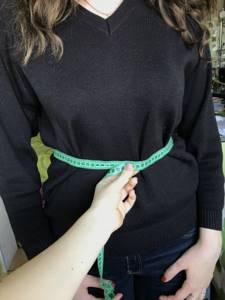
Hip circumference - measured parallel to the floor at the most voluminous points of the buttocks.
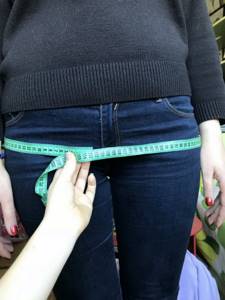
Measurements for sewing trousers
In addition to the waist and hip measurements, several more measurements are needed to design trousers:
Seat height - measured in a sitting position from the waist along the side seam to the chair.
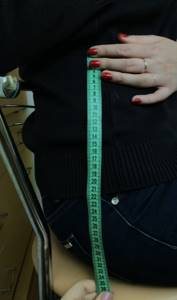
Seated measurements are best taken while sitting on a hard surface.
Knee height - measured in a standing position from the waist along the side seam to the middle of the knee.
Knee width is an extremely important measurement when sewing skinny trousers. The centimeter wraps around the bent knee.
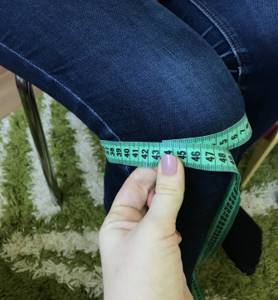
The width of the trousers at the bottom depends on the desired width of the trousers at your discretion.

Pants length - measured in a standing position from the waist along the side seam to the required length. When sewing narrow trousers, this length is taken to the bone above the foot, and if the trousers are wide, to the middle of the heel of the shoe with which you plan to wear the product.
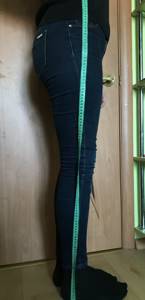
Measurements for sewing hats
Head circumference parallel to the floor - measurement is taken along the forehead and back of the head. The measuring tape must be kept strictly parallel to the floor, without tilting to either side.
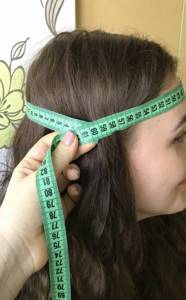
Head circumference perpendicular to the floor - measurements are taken perpendicular to the floor. The circle is from the junction of the lower jaw with the neck to the top of the head, it is also important not to tilt the centimeter to either side.

Head height is the distance from the base of the neck on the right through the top of the head to the base of the neck on the left. The head should be in a natural position without bending forward or to the sides.
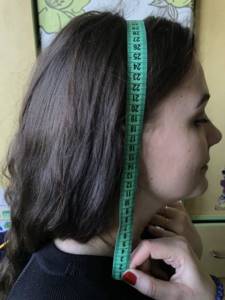
When designing a pattern, you need to know that the measurements you take will not be equivalent to the dimensions of the parts. When designing a pattern, an allowance for freedom of fit is added to the measurements - a variable value. It varies depending on the person’s build, the type of fabric, the silhouette and style of the model, as well as seasonality.
As we said earlier, a correctly constructed pattern is half the success when sewing a product. By following our advice, you will be able to design the pattern correctly, and therefore sew the desired product with the highest quality possible!
Sources:
https://krasota1zdorove.ru/zamery-tela-i-rezultaty-trenirovok/ https://gidbody.ru/problemy-s-vesom/motivacija/zamery-tela-pri-pohudenii https://frauwow.com/moda /figura/kak-snyat-merki.html
What you need for measurements
Of the available means, only one centimeter will be enough, which, most likely, every girl will have at home. There are table values for the parameters of a figure, but the problem is that the first part of the parameters may relate to one table value, and the second to another.
It is necessary to measure the proportions of the future outfit to find the correct result. At one time, experts from MADAM BOUTIQUE developed a very simple and effective system for taking measurements.
